Volunteer in the Alley
Jul 14, 2014
Jul 14, 2014
Jul 26, 2014
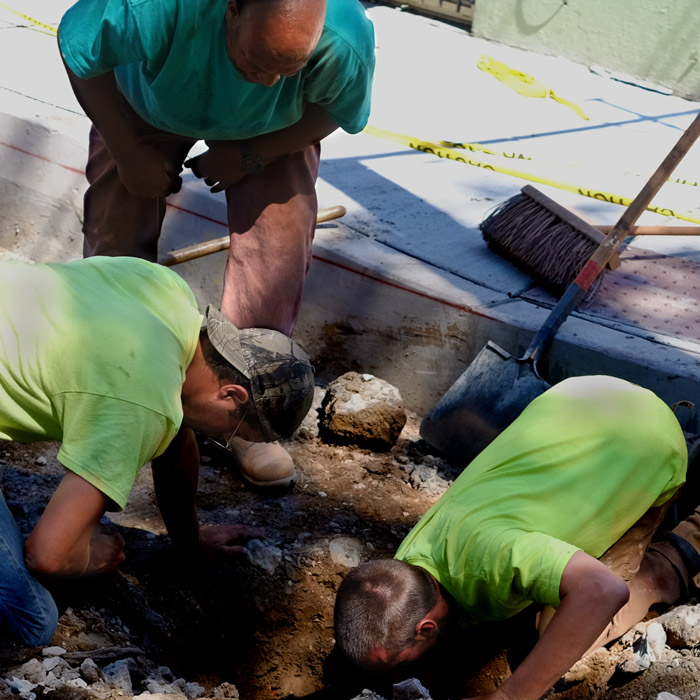 The neighbors who live along the west side of a block of 21st Street near Kater had noticed that their cold water wasn't cold any more. Right out of the tap, it was hot; one of them took its temperature and found it feverish, over a hundred degrees, which is hot enough for a nice hot shower.
The neighbors who live along the west side of a block of 21st Street near Kater had noticed that their cold water wasn't cold any more. Right out of the tap, it was hot; one of them took its temperature and found it feverish, over a hundred degrees, which is hot enough for a nice hot shower.
They called the water department, which promised to look into it. But the guys we talked to Friday morning who'd been sent to look into it might be described as less than entirely sympathetic. "They're getting free hot water," is how one of them put it. "Free hot water, and they're not happy."
The water guys suspected a leak in the steam line that runs under the sidewalk along 21st Street, which sounds like a dangerous situation, though nobody was acting particularly worried.
The guys from the steam company, on the other hand, suspected erosion under the sidewalk in the aftermath of a water main break a couple of years ago; they believed there was no longer enough dirt down there to insulate the steam line.
For reasons we cannot fully fathom, both sets of guys were looking for evidence in the sewer lines. The crew pictured here took the low-tech approach, using shovels and eyeballs; another crew had fancier technology, basically a snake with a video camera at its head, transmitting images onto a screen set up in the back of a van.
We asked what they were seeing on the screen. "Nothing yet," they said. "Just sewer."
We asked what they were looking for. They kind of snorted. "Steam," they said.
By mid-afternoon, everybody had packed up and gone home. We're not sure if they saw any steam, but the neighbors are still getting free hot water.
Jul 23, 2014
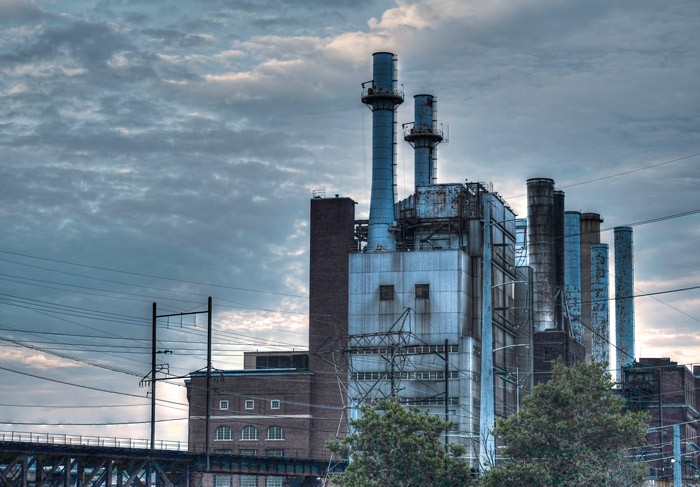 At this power plant at the edge of the neighborhood, the smokestacks that once belched day and night have been quiet now for a couple of years.
At this power plant at the edge of the neighborhood, the smokestacks that once belched day and night have been quiet now for a couple of years.
Power is still generated here at the Schuylkill complex on Grays Ferry Road, but at a newer facility immediately behind the one pictured above. Veolia Energy bought the newer part of the plant from Philadelphia's municipal electric company and converted its fuel source from oil to natural gas; that single modification reduced greenhouse gas emissions for the city as a whole, it is said, by almost 2 percent, equivalent to taking 60,000 cars off the road.
Veolia makes steam here for center city Philadelphia's centralized heating. And it does release a little smoke, not from these stacks but from a chimney behind them, not visible in the picture.
Jul 22, 2014
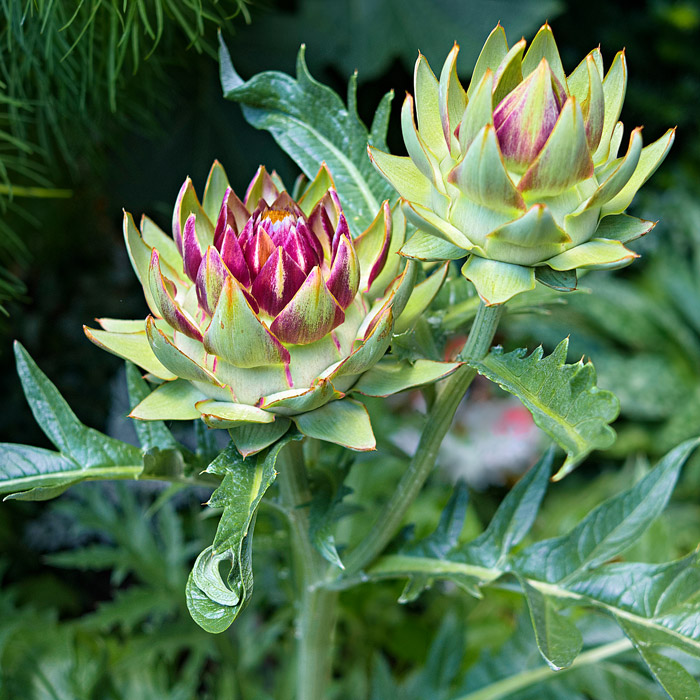 In back of the parking garage at 1700 South Street is a block-long garden on Kater Street, where nobody picked the artichokes in the edible-bud stage. They're flowers now.
In back of the parking garage at 1700 South Street is a block-long garden on Kater Street, where nobody picked the artichokes in the edible-bud stage. They're flowers now.
Aug 9, 2014
Aug 11, 2014
Aug 13, 2014
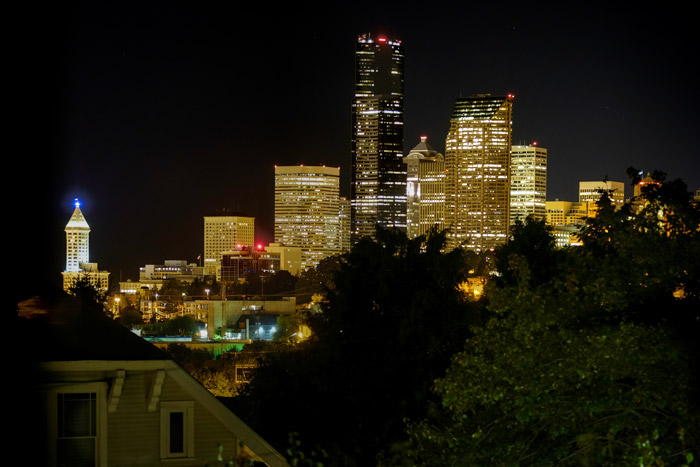 Downtown Seattle on a clear summer night, as seen from a hill near the stadiums.
Downtown Seattle on a clear summer night, as seen from a hill near the stadiums.
Aug 14, 2014

Water traffic is all backed up at Seattle's Ballard Locks on a sunny summer afternoon. Fortunately, there are a pair of locks straddling this dam, and even the smaller of the two–the lock shown here–can handle a couple of dozen small craft at a time.
The larger of the Ballard Locks was designed to allow passage by the largest ocean liner in existence, which at that time (1911) was the Lusitania. However, by the time the locks opened to traffic in 1917, the Lusitania had been sunk.
The boats in the photo above are all headed away from the City of Seattle and out toward saltwater; Puget Sound is just beyond the downstream end of the lock. Back upstream are numerous wharves and marinas and a couple of lakes. Although the Port of Seattle that handles today's largest tankers and container ships is accessed directly from the Sound, pleasure craft and smaller ships carrying more than a million tons of cargo still pass through these locks each year, utilizing smaller ports along the Ship Canal, including the homeport of much of the Bering Sea fishing fleet.
Depending on the tides and the water level of the lakes inland, the locks here raise or lower boats about 15 to 30 feet.
Aug 25, 2014
This is the story we heard Saturday on the street. Of course, none of it is confirmed.
So. There's this guy who bought a penthouse atop a nice new condo tower on 18th Street, half a block north of Rittenhouse Square. His unit includes a nice big terrace that wraps around at least two sides of the building; his views must include virtually all of downtown Philadelphia and beyond. Expansive, and no doubt expensive.
But not good enough. He didn't like his windows, we're told. He wanted to replace them with better windows and, apparently, more windows. He wanted lots and lots of really, really big windows. Three long trailer trucks full of windows.
Problem was, the new windows wouldn't fit in the elevator to get them up to his penthouse.
He needed a crane, and not just any crane. To operate in the cramped confines of a narrow city street laid out in the days of William Penn, the crane had to lift glass straight up for hundreds of feet and then rotate without bumping into any of the buildings thereabouts and deposit the glass gently on the penthouse terrace. Vehicular traffic could be blocked during this process, but not pedestrian traffic; nearby businesses wanted to keep their doors open the entire time.
There were only three cranes on the east coast, we were told, that could handle this sort of job. One of them was hauled to Rittenhouse Square on Saturday morning. In pieces.
Another crane was needed to help put the big crane together. In case you were wondering, the pieces are held together with big cotter pins.
Police officers were needed to direct traffic around the closed-off block. City buses were rerouted and sometimes delayed, forced into attempting painstaking tight turns onto streets not really suitable for them.
Two large crews of workmen were on duty all day, a crew of heavy equipment guys and a crew of glaziers from Local 262.
So there's the cost of the new windows, and of a rare, expensive crane that had to be assembled by a second crane, plus three tractor trailers to haul in the windows, various vehicles to haul the parts of the cranes, two crews at union wages, lots of expensive permits to block a street and redirect traffic and park all the trucks all day . . .
And then later, after all the new windows are up on the penthouse terrace, there will be the expense of removing the old windows, redoing the walls to accommodate the new windows, installing them . . .
We were told $250,000. Does that sound right to you?
Aug 26, 2014
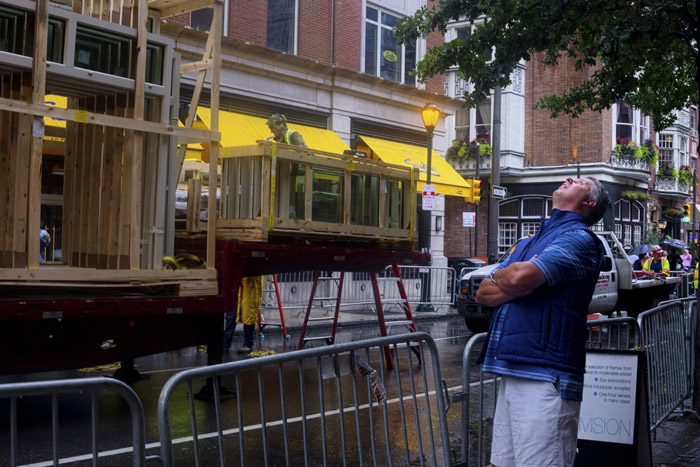 The penthouse dilemma story in yesterday's Good Morning was evidently inaccurate and incomplete.
The penthouse dilemma story in yesterday's Good Morning was evidently inaccurate and incomplete.
Among the dozens of onlookers who spent much of the day Saturday supervising the crane assembly and glass-lifting from the sidewalk was a neighbor, Carolyn, not pictured above, who had the real scoop.
The crane, she reports, arrived on seventeen tractor trailers. The guys assembling it say it's one of three of its kind in the entire country.
And the glassworkers were from Local 252, not 262 as written in these pages.
Several commenters observed that the estimate of a quarter million dollars to pay for new windows was likely on the low side. They believe the actual expense could be two or even three times as high.
But the main thing is: a good time was had by all.
Nov 6, 2014
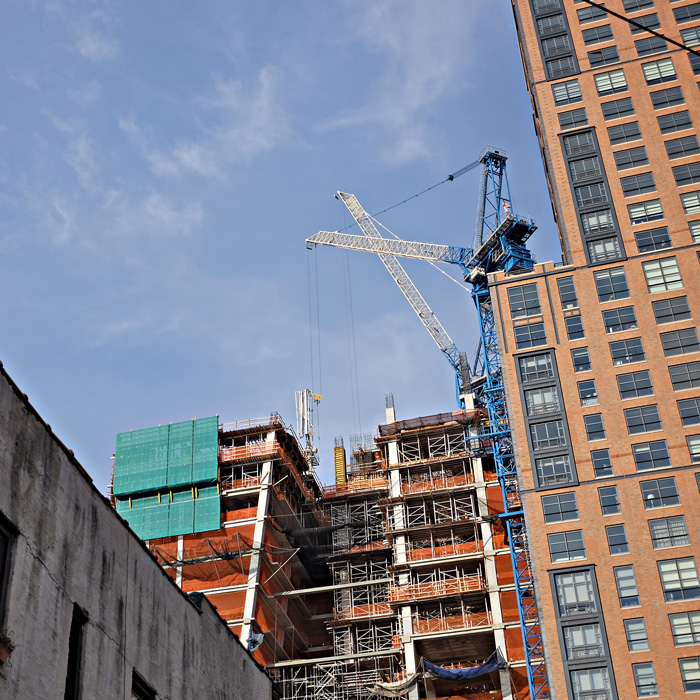 Two cranes get their act together high in the sky above New York City's High Line promenade.
Two cranes get their act together high in the sky above New York City's High Line promenade.
Many, many cranes are hard at work these days in that neck of the woods; apparently, real estate developers are firmly of the opinion that people will pay even more than the usual Manhattan rates to live in an apartment or condo near the High Line. They may be right; nobody's yet found the ceiling on what New Yorkers will pay for anything.
Nov 11, 2014
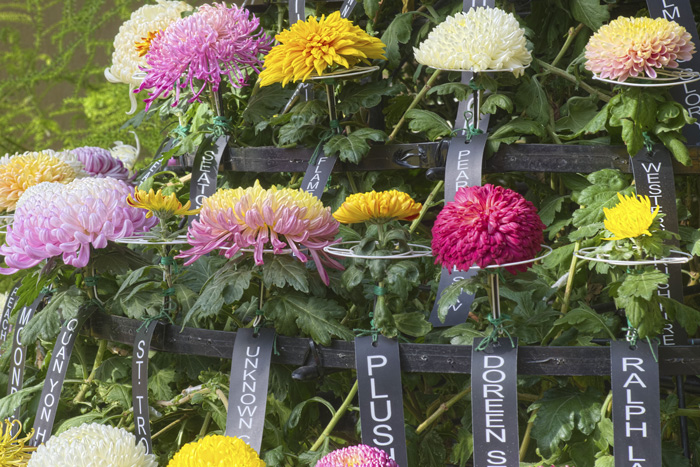 'Tis not the season yet for Philly's New Years Day Mummery on parade, but mums of spectacular colors and colorful spectacle are already among us, at the Longwood Gardens Chrysanthemum Festival.
'Tis not the season yet for Philly's New Years Day Mummery on parade, but mums of spectacular colors and colorful spectacle are already among us, at the Longwood Gardens Chrysanthemum Festival.
Above, the Longwood horticulturists grafted more than a hundred varieties of mums onto a single stem and somehow got them all blooming at the same time.
Below is a single bloom of the 'Nijin Bigo' cultivar, which we are told translates as 'Irregular incurve' Chrysanthemum morifolium.
And below that is the festival scene, in Longwood's main conservatory in Kennett Square, Pennsylvania.
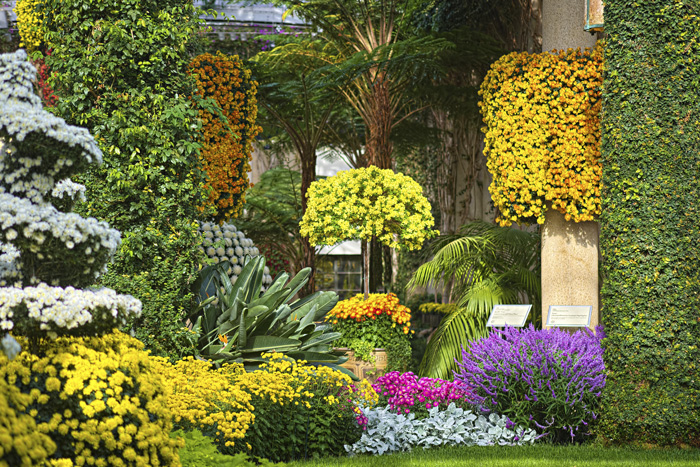
Nov 13, 2014
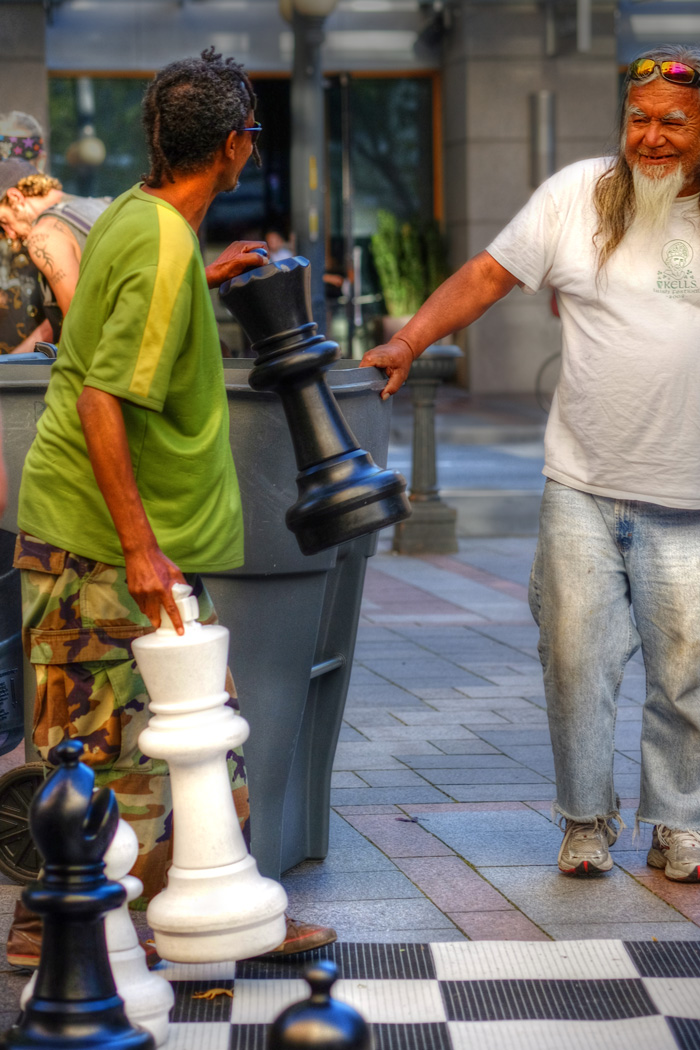 Picking up the pieces last summer in the plaza at downtown Seattle's Westlake Mall.
Picking up the pieces last summer in the plaza at downtown Seattle's Westlake Mall.
Nov 15, 2014
Dec 29, 2014
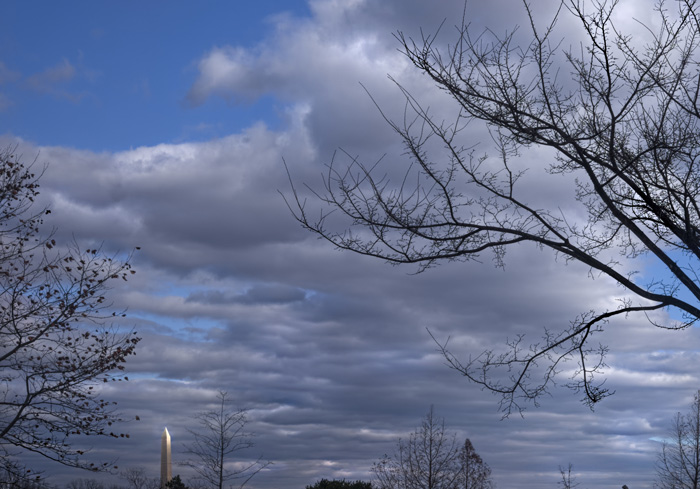 The only skyscraper in the city of Washington, as glimpsed from Arlington National Cemetery.
The only skyscraper in the city of Washington, as glimpsed from Arlington National Cemetery.
Dec 31, 2014
 The Schuylkill Expressway, as glimpsed from across the river in South Philly.
The Schuylkill Expressway, as glimpsed from across the river in South Philly.
Jan 24, 2015
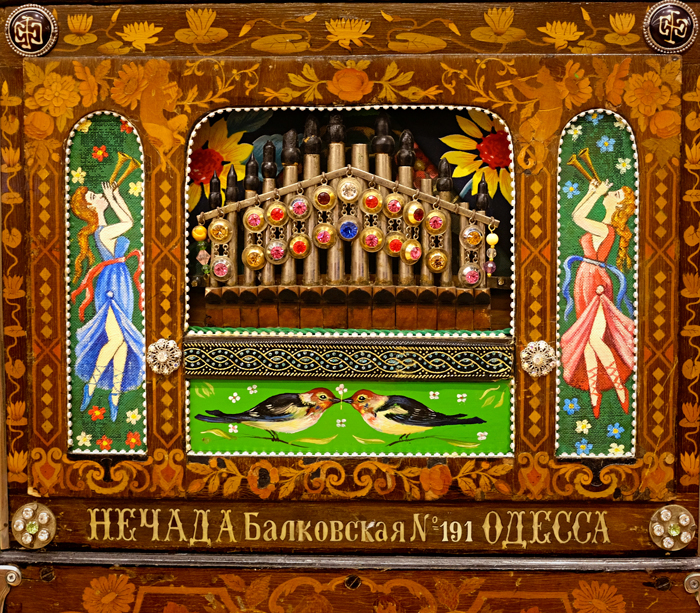 This is the front panel of a Nechada barrel organ, made in Odessa, Ukraine, in the early years of the twentieth century. It was often set up in the street outside a bar or brothel, in hopes that the popular tunes it blasted out would draw a crowd of potential customers. Sometimes, of course, the organ grinder had a monkey as an added attraction, or a troupe of very young girls, perhaps eight or ten years old, who danced and sang and turned cartwheels to entertain the drunks.
This is the front panel of a Nechada barrel organ, made in Odessa, Ukraine, in the early years of the twentieth century. It was often set up in the street outside a bar or brothel, in hopes that the popular tunes it blasted out would draw a crowd of potential customers. Sometimes, of course, the organ grinder had a monkey as an added attraction, or a troupe of very young girls, perhaps eight or ten years old, who danced and sang and turned cartwheels to entertain the drunks.
Odessa was home to a number of piano manufacturers, who made these organs as a sideline. No musical skill was required to operate them; the organ grinder just turned the crank on one side of the box, which pumped air through the organ pipes and also spun rolls of paper that had been pre-programmed with the desired musical compositions. The paper blocked air from entering the pipes except where holes had been punched; when a hole in the paper came in line with the opening to a pipe of the desired pitch, air was forced through the pipe, generating each note of a song.
Odessa street organs, called sharmankas, were sold throughout the Russian empire from about 1860 until they began to be replaced by more modern music machines, notably record players, in the 1920s. Even then, they remained in use by street buskers, particularly in Tbilisi and other Georgian cities, where street organs were popular well into the 1960s.
The inscription across the bottom of this organ gives the name and address of its maker. Ivan Viktorovich Nechada worked out of a piano factory on Balskovskaya Street, now Isaac Babel Street, in Odessa. This organ is in the collection of the new Musical Instrument Museum in Phoenix, Arizona, but recently a very similar Nechada organ, said to be in perfect working order, was advertised in Moscow; "May be sold or exchanged for a car," wrote the seller, in an ad in Mechanical Music Digest.
Jan 26, 2015
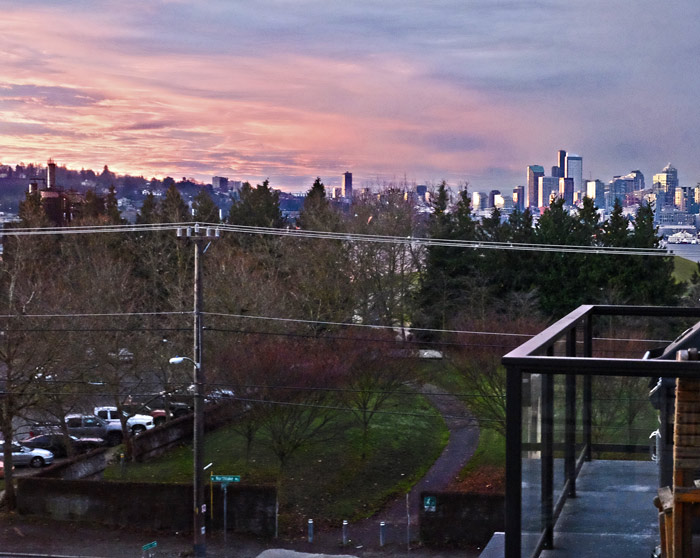 The sun rises over Gasworks Park and Lake Union in Seattle, or at least it tries to. The clouds scuttling into town from the the west (right edge of this picture) are about to roll all over the golden disk and thus reestablish normal winter gloom.
The sun rises over Gasworks Park and Lake Union in Seattle, or at least it tries to. The clouds scuttling into town from the the west (right edge of this picture) are about to roll all over the golden disk and thus reestablish normal winter gloom.
Feb 3, 2015
 A couple of weeks ago, in the desert near Pinnacle Peak, outside of Phoenix, people who stepped out of their cars to savor the sunset felt the wind pick up suddenly, blowing hard and cold and carrying . . . raindrops? Really?
A couple of weeks ago, in the desert near Pinnacle Peak, outside of Phoenix, people who stepped out of their cars to savor the sunset felt the wind pick up suddenly, blowing hard and cold and carrying . . . raindrops? Really?
Careful examination of clouds in the distance revealed ragged curtains of rain showers swirling down just below the cloud line. Apparently, most of the rain evaporated long before moistening the dust, but we can vouch for several drops, perhaps even several dozens of drops, that fell all the way to earth.
After a few minutes, the wind died down, and the storm, such as it was, no longer was.
Feb 9, 2015
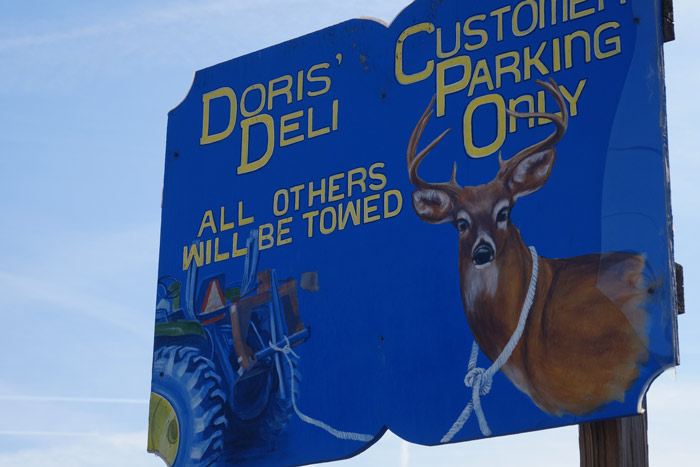 Doris's sign might be a little misleading in one way, since there's really not much of a parking problem in the community of Great Cacapon, West Virginia. It's a wide place in the road: a post office, a few dozen houses and trailers, and Doris's, which advertises Bud Light by the 30-pack ($23.99).
Doris's sign might be a little misleading in one way, since there's really not much of a parking problem in the community of Great Cacapon, West Virginia. It's a wide place in the road: a post office, a few dozen houses and trailers, and Doris's, which advertises Bud Light by the 30-pack ($23.99).
The deer in the noose, however, looks just like the wall mounts on sale at a furniture store back in Berkeley Springs, the county seat. And if you don't want a deer for your wall, you might consider a longhorn steer instead.
Feb 10, 2015
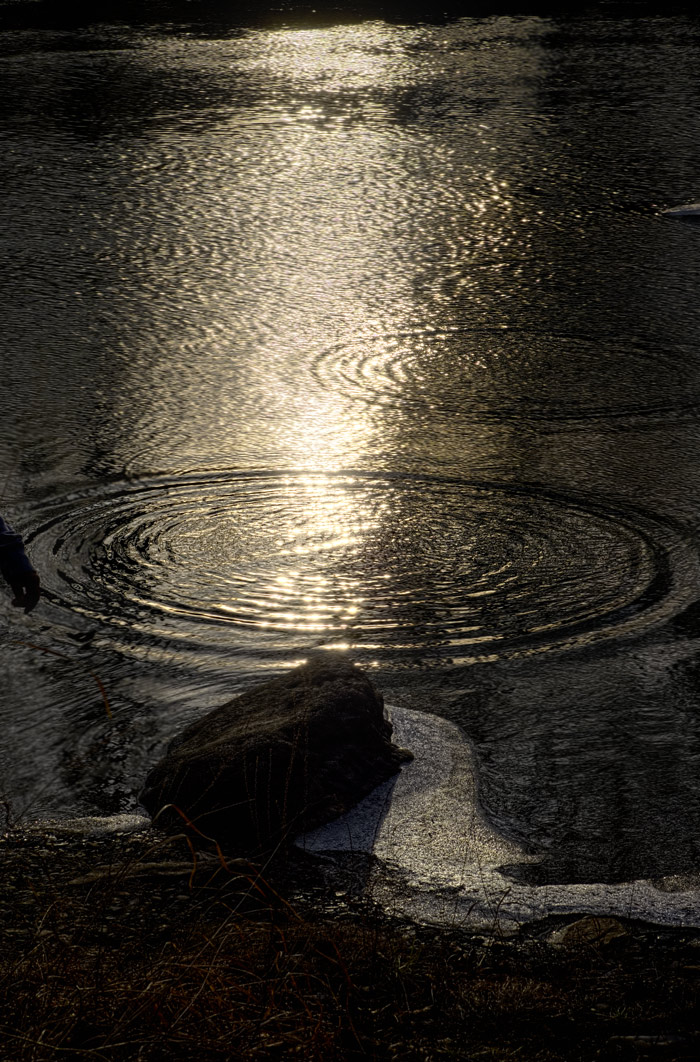 It was a nice flat little rock that hopped across a nice icy little river, at the foot of a nice little rocky mountain in the eastern panhandle of West Virginia.
It was a nice flat little rock that hopped across a nice icy little river, at the foot of a nice little rocky mountain in the eastern panhandle of West Virginia.
To see how it's done, see here.
Feb 12, 2015
 In 1748, George Washington was a 16-year-old kid hired to help out with a surveying party in the mountain wilderness that is now eastern West Virginia. The surveyors stopped to rest in a narrow valley known now as Berkeley Springs. Young Washington described the valley as unpleasantly narrow, scarcely touched by the sun, but after spending a few days soaking in warm springs that bubbled up out of the ground there, he decided he liked the place.
In 1748, George Washington was a 16-year-old kid hired to help out with a surveying party in the mountain wilderness that is now eastern West Virginia. The surveyors stopped to rest in a narrow valley known now as Berkeley Springs. Young Washington described the valley as unpleasantly narrow, scarcely touched by the sun, but after spending a few days soaking in warm springs that bubbled up out of the ground there, he decided he liked the place.
Two years later, when Lord Fairfax, who had commissioned the survey, finally got around to paying the survey party, Washington took his pay in the form of land grants in and around Berkeley Springs. Those grants of 250 acres were the first of numerous grants and purchases over the years that expanded his holdings throughout Virginia, especially western Virginia, till at his death the father of our country personally owned more than 60,000 acres of our country.
The "bathtub" at Berkeley Springs is a modern recreation of the rock-lined pools built in the center of town for the crowds of spa-goers in mid-eighteenth-century America who sought the curative powers attributed to warm (78.4 degrees F), mineralized spring waters. Until 1784, when the first bathhouse was completed, the spa was entirely out of doors, in rock pools screened for privacy by piles of brush and woven branches. Separate hours were designated for male and female bathers.
Washington was part of the crowd; he visited repeatedly, at first with his half-brother Lawrence, who was ill with tuberculosis. When the baths did not help, George took Lawrence on an ocean voyage to Barbados, in hopes that tropical air might prove curative. In Barbados, George Washington contracted smallpox but recovered; Lawrence Washington continued to do poorly and returned to Virginia to die at home in 1752.
George Washington returned again and again to the baths at Berkeley Springs, which had become something of a social scene for colonials of his class. The town grew rapidly to wine and dine the bathers, and George Washington bought up several building lots. A house was built for him on one of his lots, but the Revolutionary War was diverting his attention at that time, and it is believed he only visited the house once.
In mid-winter, the water in Washington's bathtub looks disgusting; the spring is warm enough that there's little or no ice in the pool around the spring but plenty of algae and moss, and nobody has cleaned fallen leaves out of the tub. But straight from the springs, Berkeley Springs water is clear and fresh-tasting. The town hosts an annual water-tasting competition, at which its own municipal water usually fares well.
And there's another annual event in town: George Washington's Bath Tub Weekend, celebrated each year around March 18, the day Washington first showed up for a bath in 1748. The weekend "highlights history-related activities," according to its promoters, "and retail sales."
Feb 22, 2015
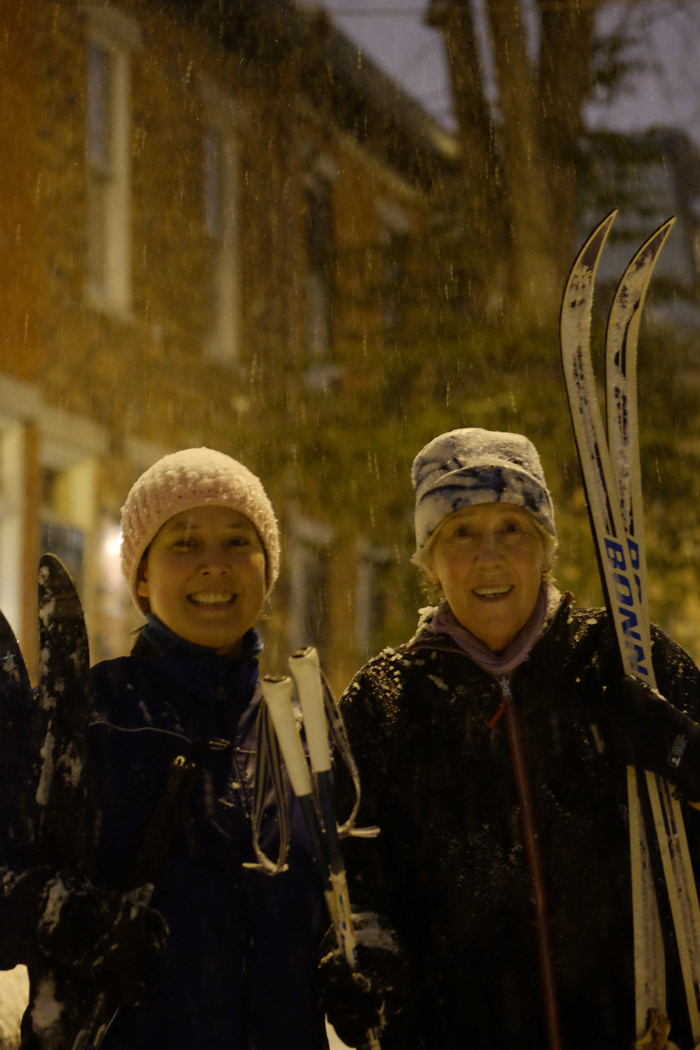 We offer a robust winter sports program here in Kater Street. See, for example.
We offer a robust winter sports program here in Kater Street. See, for example.
Mar 1, 2015
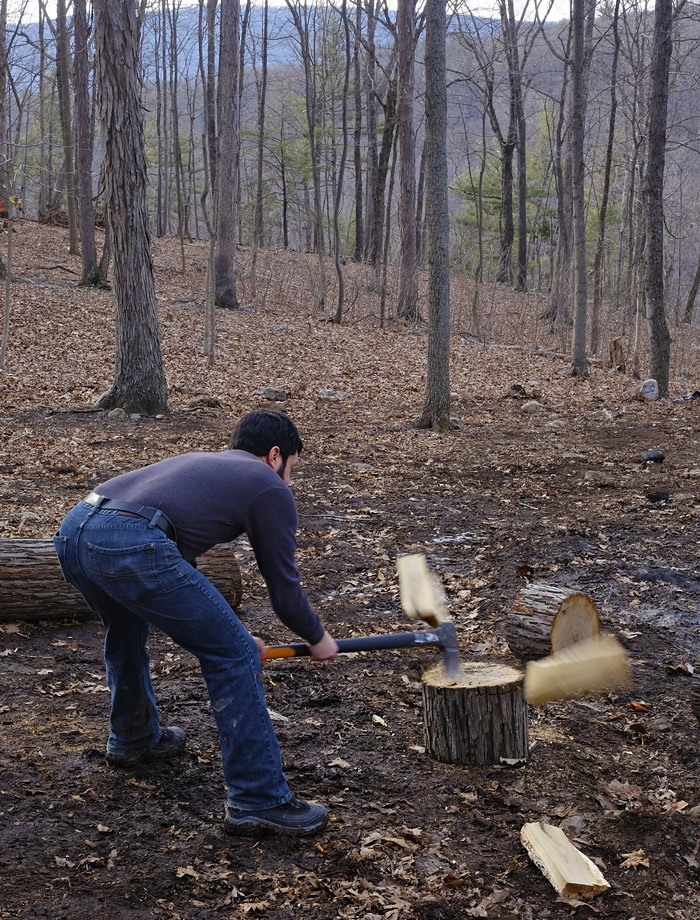 Up in Tedland, high on the mountain above the Cacapon River, to get warm at all, you have to get warm twice. Or else wait till June and get all the warm you want, and then some.
Up in Tedland, high on the mountain above the Cacapon River, to get warm at all, you have to get warm twice. Or else wait till June and get all the warm you want, and then some.
Apr 11, 2015
 One week ago, on a chilly but sunny New York afternoon, this espaliered pear tree in the Cloisters medieval garden was trying really, really hard to leaf out.
One week ago, on a chilly but sunny New York afternoon, this espaliered pear tree in the Cloisters medieval garden was trying really, really hard to leaf out.
Apr 20, 2015
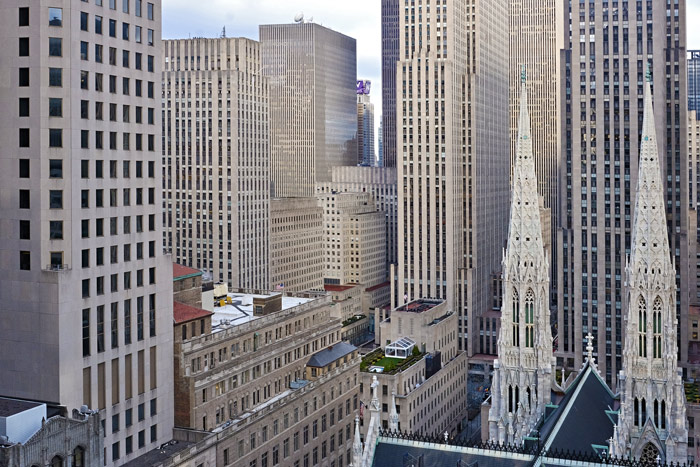 St. Patrick's Cathedral from behind and a little bit above, in midtown Manhattan. We enjoyed this view from the window of our hotel room during a recent trip to New York.
St. Patrick's Cathedral from behind and a little bit above, in midtown Manhattan. We enjoyed this view from the window of our hotel room during a recent trip to New York.
May 23, 2015
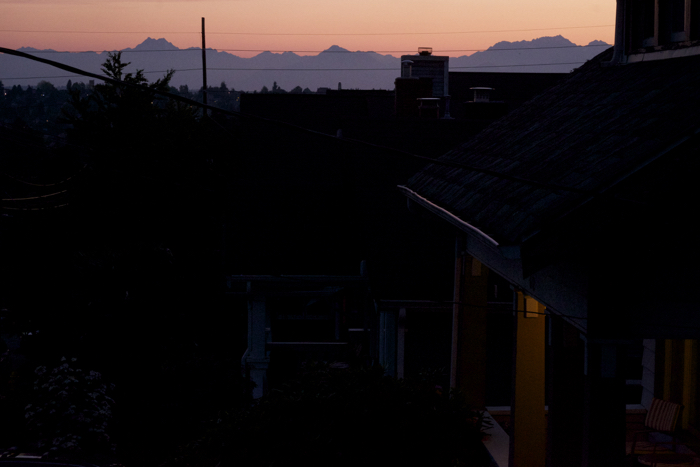 Night comes to NE 78th Street in Seattle.
Night comes to NE 78th Street in Seattle.
A few stray power lines hint at the electrical substation down the hill but don't even come close to hiding the Olympic Mountains on the horizon.
May 24, 2015
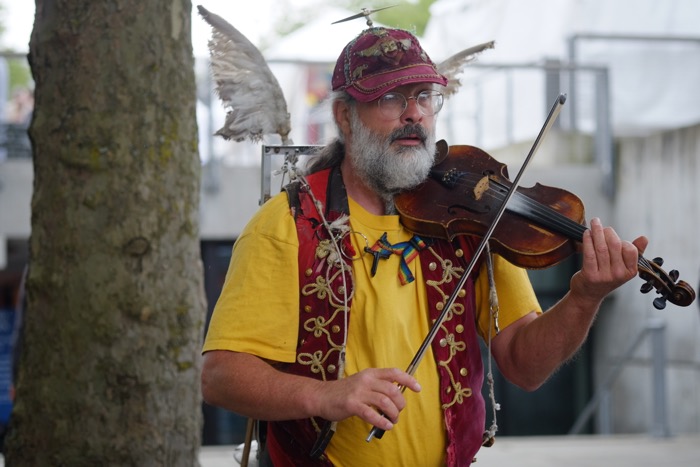 This flying fiddler at Seattle's Northwest Folklife Festival could probably give Dick Van Dyke's Bert from Mary Poppins a run for the money. Like Bert, he wore tambourines and snares and whatnot, all operated with a hop, skip, and a jump, but this guy also had wings and, best of all, coconut shells to create Monty Python-style hoofbeats.
This flying fiddler at Seattle's Northwest Folklife Festival could probably give Dick Van Dyke's Bert from Mary Poppins a run for the money. Like Bert, he wore tambourines and snares and whatnot, all operated with a hop, skip, and a jump, but this guy also had wings and, best of all, coconut shells to create Monty Python-style hoofbeats.
Jan 28, 2016
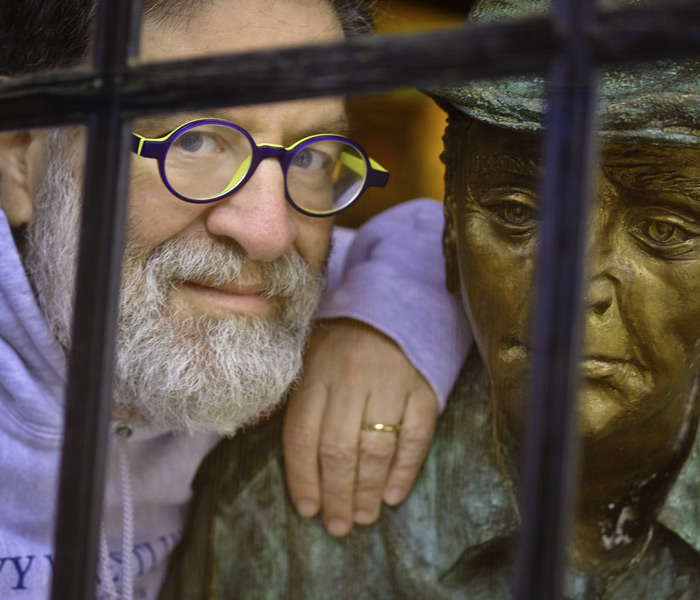 That's the Quiet Man with Norman, at the window of Delia Foley's tavern in Baltimore. He's quiet all right, albeit a little shrunken, not exactly John Wayne–sized. Still and all, anybody who's that solid and bronze has got to have a good, strong shoulder to lean on.
That's the Quiet Man with Norman, at the window of Delia Foley's tavern in Baltimore. He's quiet all right, albeit a little shrunken, not exactly John Wayne–sized. Still and all, anybody who's that solid and bronze has got to have a good, strong shoulder to lean on.
Feb 4, 2016
 Ten or so days ago, when Philly got whacked by a pretty good thump of snow, this guy was the only one out driving around in the neighborhood, until he wasn't.
Ten or so days ago, when Philly got whacked by a pretty good thump of snow, this guy was the only one out driving around in the neighborhood, until he wasn't.
He was going the wrong way up 24th Street–and really, why not? There were no other cars on the road. But he slipped and slid, and then he was digging and digging. . . .
One of the neighbors brought him some cardboard, which was eventually helpful, but nobody offered to help him shovel, which might have made a more immediate contribution. (In our own defense, it is noted here that ever since last August, when we moved into an apartment, we no longer own a snow shovel.)
It's warmed up now and rained, and the snow is disappearing. Maybe this next month will bring us more winter, but maybe not.
Feb 7, 2016
 Last spring, when we were packing up my mother's place for her cross-country move, we came across this relic of a much earlier stage of life.
Last spring, when we were packing up my mother's place for her cross-country move, we came across this relic of a much earlier stage of life.
My mother remembered it well, in considerable detail: it's a cap pistol that belonged to my little brother Charlie, and she confiscated it, oh, fifty-some years ago, when he and his friends were making too much noise with it in the house. She told him to take it outside, but he kept on shooting it in the house.
She doesn't remember exactly where she put the gun after taking it up, but it was obviously a really good hiding place. We found it in the back of a closet, and this was a different closet, in a different house, from the place we'd lived during the era of confiscatory gun control.
And that's not all. We also found another weapon, not pictured here, traceable to the same perp: a huge water gun of the Super Soaker ilk. That one, too, had been confiscated and squirreled away, presumably for exactly the same violation.
My mom is tough. Sure, teach a lesson, take the things away for a day or a week. But fifty years?
Whatever, it worked. Chuck didn't grow up to be a cowboy; he's a nuclear physicist now, who never shot anybody.
The guns went to Goodwill, if I remember correctly. Somebody else's little cowboy can get in trouble with them now.
Feb 11, 2016
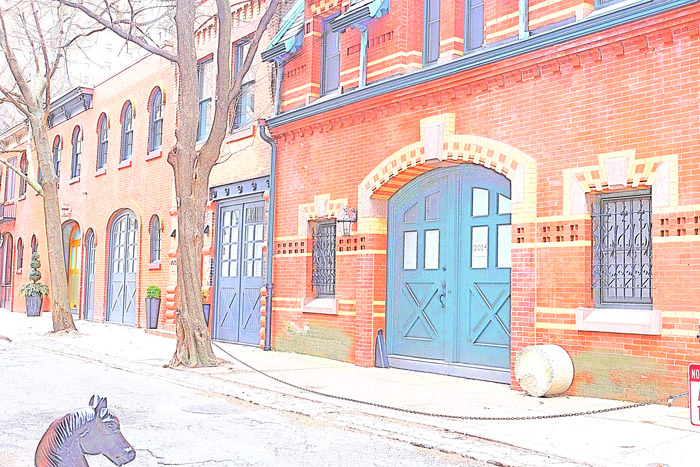 In 1860, when grand homes were being built along Walnut Street west of Rittenhouse Square, the need arose for grand stables nearby.
In 1860, when grand homes were being built along Walnut Street west of Rittenhouse Square, the need arose for grand stables nearby.
An entire block of a side street–then called Heberton, now Chancellor–was upgraded to house the carriages and steeds of the new Rittenhouse elite. The street was paved with granite blocks and widened to twice the usual side-street width, so that carriages could be driven directly in and out of stable doors, instead of being dragged by humans into the street and then turned before hitching the horses.
Five of the stables have survived; they are now condos and office suites, with garage parking in back. The block is a popular site for wedding photography.
In back of the stables is a much narrower street–Millowney then, St. James now–that housed the servants.
Feb 14, 2016
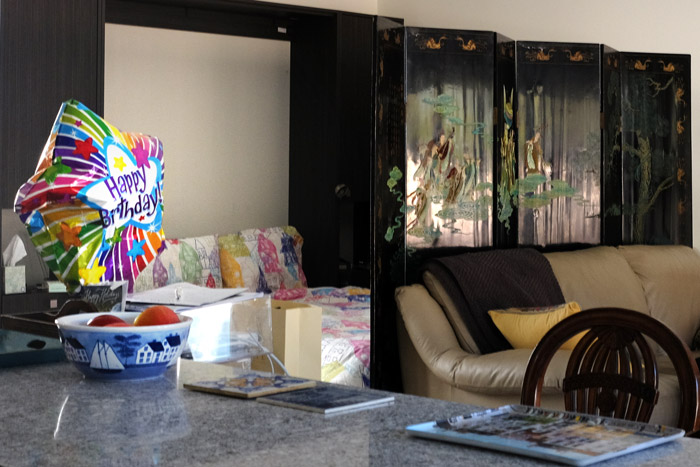 a happy, happy
a happy, happy birthday Valentine's Day!
Feb 16, 2016
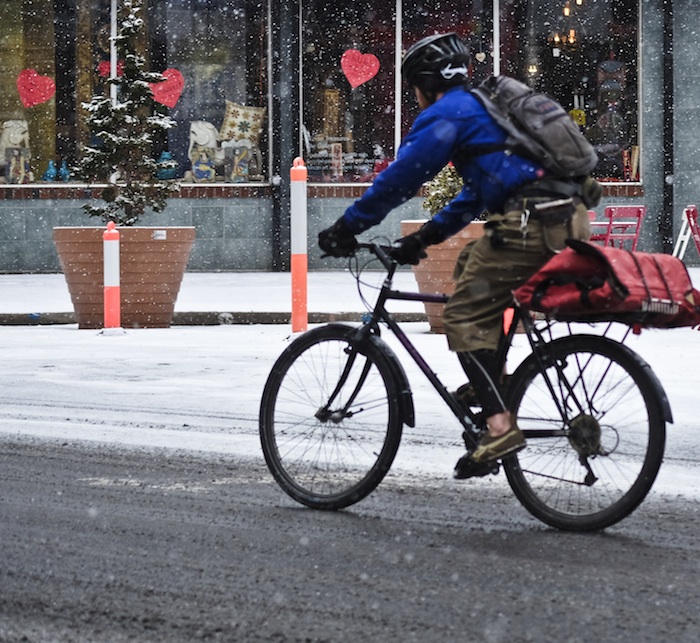 Presidents' Day has already come and gone, and they still haven't taken down the Valentine's decorations.
Presidents' Day has already come and gone, and they still haven't taken down the Valentine's decorations.
Feb 21, 2016
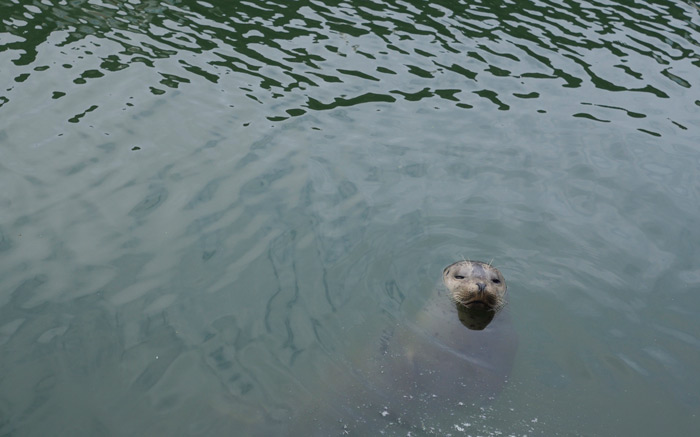 One of the hangers-on at a marina near Everett, Washington, pokes his head up from the waters of Puget Sound in hopes that the incoming salmon-fishing charter boats had a good day.
One of the hangers-on at a marina near Everett, Washington, pokes his head up from the waters of Puget Sound in hopes that the incoming salmon-fishing charter boats had a good day.
Feb 29, 2016
Mar 2, 2016
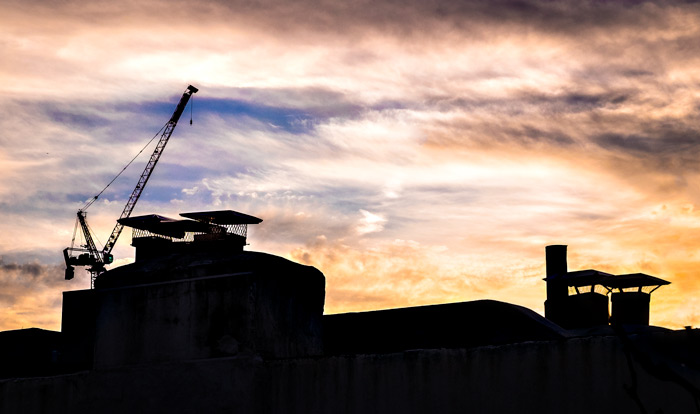 Nothing stays the same. Day goes to night. Some weather's coming in. And off in the distance there's that harbinger of something big in the works–23 stories big, we're told. In a few months, the view out this window should be kinda different. Watch this space.
Nothing stays the same. Day goes to night. Some weather's coming in. And off in the distance there's that harbinger of something big in the works–23 stories big, we're told. In a few months, the view out this window should be kinda different. Watch this space.
Mar 31, 2016
 We noticed the other day that on 9th Street in the Italian Market, they sell pet turtles just like Rocky's turtles in the movies.
We noticed the other day that on 9th Street in the Italian Market, they sell pet turtles just like Rocky's turtles in the movies.
What we don't know is which came first, Rocky or the turtles. Did Sylvester Stallone put turtles in the movies because they were a South Philly thing? Or do they sell turtles in the market now because people want to buy Rocky things?
Or, as the cool kidz say nowadays, what people want to buy is Rocky jawn.
May 28, 2016
 The bronze Ben Franklin standing atop City Hall's dome is said to be the tallest statue anywhere that's on top of a building. He's 37 feet tall and weighs 27 tons.
The bronze Ben Franklin standing atop City Hall's dome is said to be the tallest statue anywhere that's on top of a building. He's 37 feet tall and weighs 27 tons.
This picture of Ben from behind was taken from the new observation deck on the 57th floor of One Liberty Place a couple of blocks away.
May 29, 2016
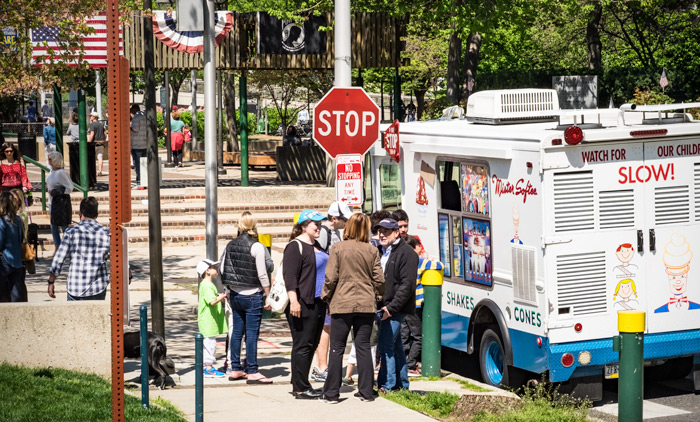 The Little League games were in full swing when Mister Softee showed up at Taney Park. So the players couldn't just leave the field and run over to the truck–but the grownups could.
The Little League games were in full swing when Mister Softee showed up at Taney Park. So the players couldn't just leave the field and run over to the truck–but the grownups could.
The park entrance is red, white, and blue for Memorial Day, and also for every other day; a nearby plaque memorializes neighborhood boys who died in Vietnam. This picture was taken a couple of weeks ago, though the scene will look the same today, albeit with a wardrobe adjustment to deal with much, much warmer and muggier temperatures.
Jun 6, 2016
 An old skyscraper, the Art Deco Suburban Station building from 1930, peeks out at left from behind Philadelphia's newest and tallest skyscraper, the Comcast Center, completed in 2008. Reflected in the angled blue glass of the Concast tower are the upper floors of the Mellon Bank Center across the street.
An old skyscraper, the Art Deco Suburban Station building from 1930, peeks out at left from behind Philadelphia's newest and tallest skyscraper, the Comcast Center, completed in 2008. Reflected in the angled blue glass of the Concast tower are the upper floors of the Mellon Bank Center across the street.
Behind the 'scrapers is lots and lots of city sprawling into the night across the Delaware Valley.
Comcast is currently building itself a newer and even taller tower, which is rising off to the right of the buildings seen here. The lower floors will be occupied by Comcast and Telemundo, and the upper floors will be rooms with a view in a Four Seasons Hotel.
Jun 14, 2016
 The prairie lands around the southern end of Puget Sound were created by ice and sustained by fire.
The prairie lands around the southern end of Puget Sound were created by ice and sustained by fire.
Retreating glaciers some ten thousand years ago left behind vast stretches of land scraped bare of trees, initially supporting only grasses and other low-lying scrub, in a climate generally so humid that grassland would normally yield to forest. Much of this post-glacial prairieland did revert to forest, but by burning off the old growth every spring, Native peoples prevented tree seedlings from taking root and thus maintained many thousands of acres as grassland for grazing their horses and other livestock.
However, the prairies of Western Washington were the first land grabbed by invading Europeans; lacking tree cover, they were ready-made for cropland and pasture. Farms and cities grew. The ancient practice of annual burns was abandoned, and big trees were soon thriving.
Only a few tiny remnants of these prairies remain, grassy islands in a sea of trees, and they are ecologically degraded now to varying extents. Much of the remaining acreage is entrusted to the Center for Natural Lands Management, a nonprofit that attempts to restore and preserve the South Sound prairies. Annual burning regimes have been reinstated.
Above is a bit of the grass in Glacial Heritage Preserve, a prairie in Thurston County, Washington, that is open to the public only on volunteer work days.
Jan 1, 2017
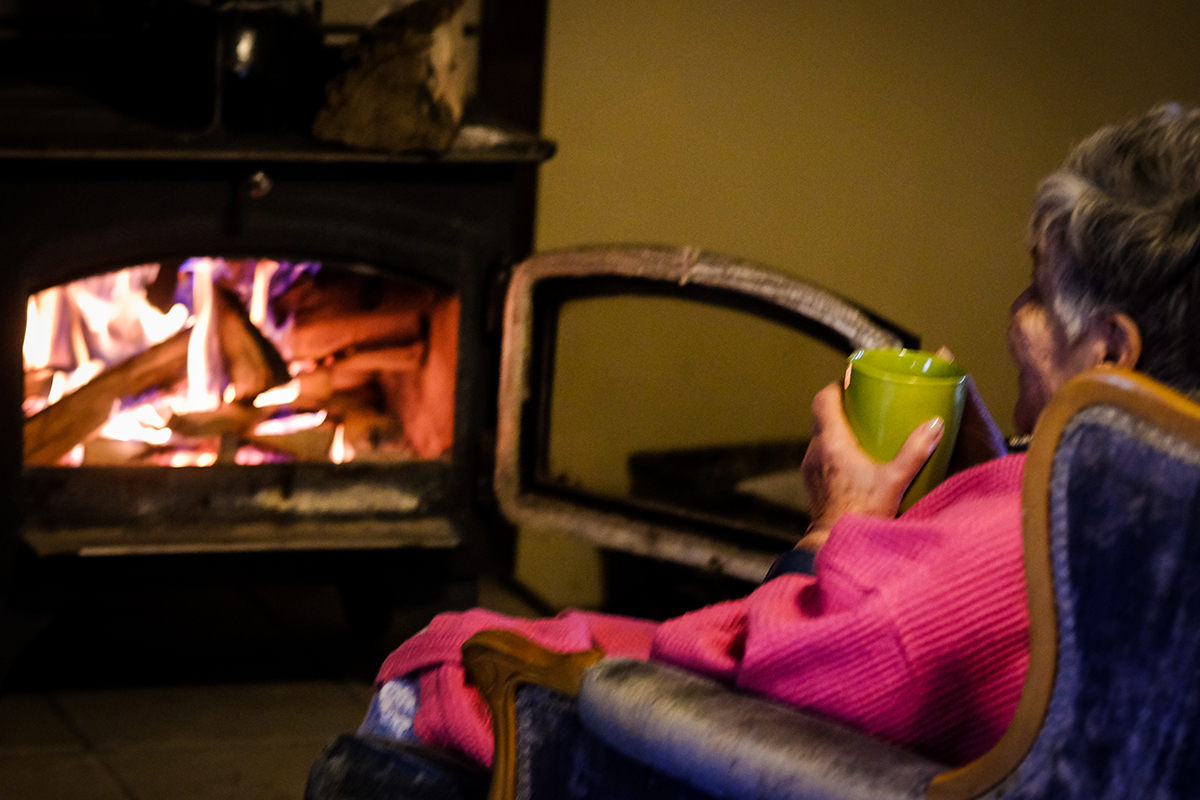 Great-Grandma Helen settles down with a cup of tea in Ted's little house in the woods on the mountain above Great Cacapon, West Virginia.
Great-Grandma Helen settles down with a cup of tea in Ted's little house in the woods on the mountain above Great Cacapon, West Virginia.
Earlier on that October day, she and Ted had split the stovewood to light up the night with a bright, crackly glow. The work warmed everybody twice, just as they say, but looking back from our current outpost on the frontier of the new year, we can actually feel that warmth a third time now, in our recollection of quiet fireside sorts of moments in which we rested, enjoyed good company, and eased the furrows of our brows.
Okay, so right now, it looks like we're all deep and soggy in an octopus's garden in the shade? Well, that would be a huge problem if we didn't have each other, so . . . . Hugs.
Jan 22, 2017
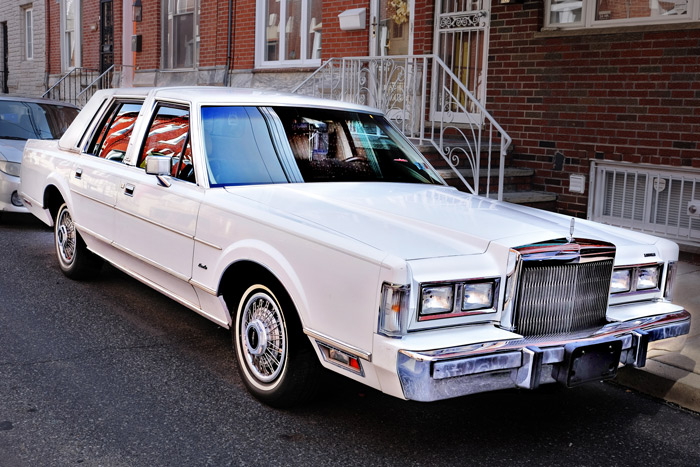 Last spring, when we first came across this scene on a block of Hicks Street in deep South Philly, we just naturally assumed that the white car was a Cadillac. Took us till now to realize that no, maybe it should be a Cadillac, but in real life it's a Lincoln Continental. Some of us are just not as observant as we need to be.
Last spring, when we first came across this scene on a block of Hicks Street in deep South Philly, we just naturally assumed that the white car was a Cadillac. Took us till now to realize that no, maybe it should be a Cadillac, but in real life it's a Lincoln Continental. Some of us are just not as observant as we need to be.
What we can say, however, based on observations of our own lyin eyes as well as gossip, is that this Lincoln is regularly washed but never driven.
Feb 13, 2017
 Late in the afternoon on a sunny winter day, if you go up to the corner and look downhill through the erector-set maze of the North Seattle Electrical Substation, you can catch a glimpse of the big volcano 90 miles away.
Late in the afternoon on a sunny winter day, if you go up to the corner and look downhill through the erector-set maze of the North Seattle Electrical Substation, you can catch a glimpse of the big volcano 90 miles away.
Mar 13, 2017
Apr 14, 2017
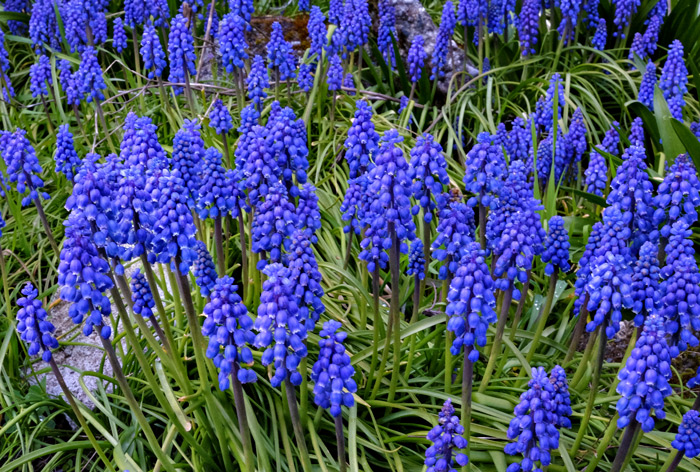 Here in the Puget Sound Lowlands, it's hyacinth season down the alley.
Here in the Puget Sound Lowlands, it's hyacinth season down the alley.
Jan 11, 2018
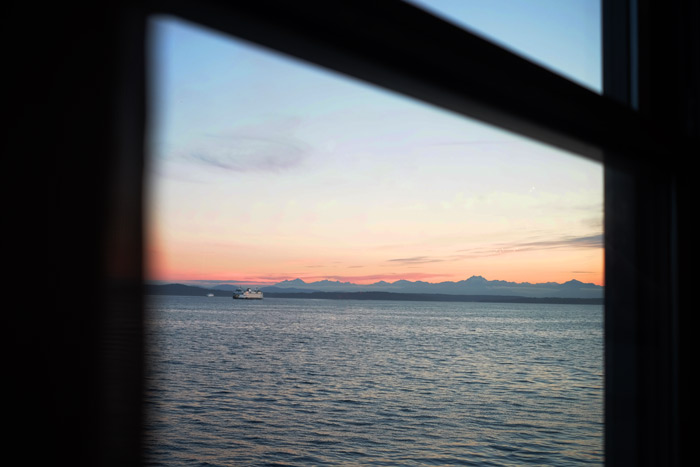 The Bainbridge Island ferry and the Olympic Mountains at sunset, as seen across Elliott Bay from the bar at Pier 67 near downtown Seattle.
The Bainbridge Island ferry and the Olympic Mountains at sunset, as seen across Elliott Bay from the bar at Pier 67 near downtown Seattle.